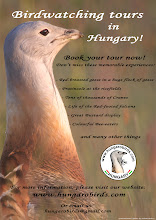During our birding tours we can see other animals as well: mammals, amphibians, reptiles etc... In this note I would like to review the mammals of this area.
On the fields we can see everywhere roe deers. The Roe Deer spends most of its life alone, preferring to live solitary except when mating during the breeding season, when we can see 20-30 animals together.
The wild boars live in groups. In our ricefields we can see a family with piglets in a sounders.
Sometimes we can find otters by the lakes. In wintertime we can see fishes had been caught by the otters on the ice.
Sometimes the red foxes come into the villages and steall a few chickens from the hen house.
The wildcat is a hunter of small

mammals and birds. We know only one family in this area.
The European Moles live in the garden of our accommodation. It is common mammal in this region.
The White-breasted Hedgehogs

are in danger, because more and more hedgehogs are run over by cars.
In spring time we can see the hares to box.
We have here other mammals as well, but some of these animals are too small or too secretive, so we can't observe them. They are voles, mice, shrews and the bats.







